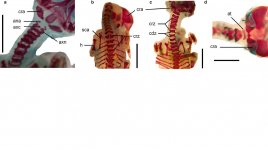Fred Ruhe
Well-known member

Tomasz Skawiński, Bartosz Borczyk & Lucyna Hałupka, 2020
Postnatal ossification sequences in Acrocephalus scirpaceus and Chroicocephalus ridibundus (Aves: Neognathae): The precocial–altricial spectrum and evolution of compound bones in birds
Journal of Anatomy (advance online publication)
doi: https://doi.org/10.1111/joa.13303
https://onlinelibrary.wiley.com/doi/10.1111/joa.13303
Abstract
Although the development of the avian skeleton has attracted considerable attention, most of the studies have been concentrated on the embryonic period, while studies on the postnatal period are rare. We studied the postnatal development of the skeleton in two phylogenetically distant birds, an altricial passerine Acrocephalus scirpaceus and a semiprecocial charadriiform Chroicocephalus ridibundus. The neonates of the former, despite being altricial, have well‐ossified skeleton—the degree of development approaches that of the semiprecocial gull. However, after hatching the limb bones (particularly those of the hind limb) ossify earlier in the gull which is probably related to faster acquisition of locomotor abilities. We have observed that, in contrast to previous reports from neognathous birds, in the ankle of the gull, the ascending process fuses with the astragalus rather than with the calcaneum. This type of development is present in palaeognaths and nonavian dinosaurs but has not yet been reported in neognaths. This indicates a greater diversity within Neognathae and suggests a more complex scenario for the evolution of the avian ankle. However, data from a greater number of species are needed to establish the developmental sequence ancestral for neognathous birds. Furthermore, the sequence of bone fusions in the wrist of Acrocephalus is similar to the fossil‐documented evolutionary sequence observed in the phylogeny of early birds, with the semilunate carpal and major metacarpal fusing first, followed by the alular metacarpal fusing with the major metacarpal and then the major and minor metacarpal fusing proximally. These data underscore the importance of developmental studies for reconstructing the evolutionary history.
Enjoy,
Fred
Postnatal ossification sequences in Acrocephalus scirpaceus and Chroicocephalus ridibundus (Aves: Neognathae): The precocial–altricial spectrum and evolution of compound bones in birds
Journal of Anatomy (advance online publication)
doi: https://doi.org/10.1111/joa.13303
https://onlinelibrary.wiley.com/doi/10.1111/joa.13303
Abstract
Although the development of the avian skeleton has attracted considerable attention, most of the studies have been concentrated on the embryonic period, while studies on the postnatal period are rare. We studied the postnatal development of the skeleton in two phylogenetically distant birds, an altricial passerine Acrocephalus scirpaceus and a semiprecocial charadriiform Chroicocephalus ridibundus. The neonates of the former, despite being altricial, have well‐ossified skeleton—the degree of development approaches that of the semiprecocial gull. However, after hatching the limb bones (particularly those of the hind limb) ossify earlier in the gull which is probably related to faster acquisition of locomotor abilities. We have observed that, in contrast to previous reports from neognathous birds, in the ankle of the gull, the ascending process fuses with the astragalus rather than with the calcaneum. This type of development is present in palaeognaths and nonavian dinosaurs but has not yet been reported in neognaths. This indicates a greater diversity within Neognathae and suggests a more complex scenario for the evolution of the avian ankle. However, data from a greater number of species are needed to establish the developmental sequence ancestral for neognathous birds. Furthermore, the sequence of bone fusions in the wrist of Acrocephalus is similar to the fossil‐documented evolutionary sequence observed in the phylogeny of early birds, with the semilunate carpal and major metacarpal fusing first, followed by the alular metacarpal fusing with the major metacarpal and then the major and minor metacarpal fusing proximally. These data underscore the importance of developmental studies for reconstructing the evolutionary history.
Enjoy,
Fred




